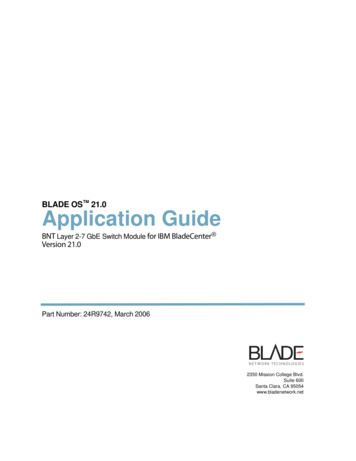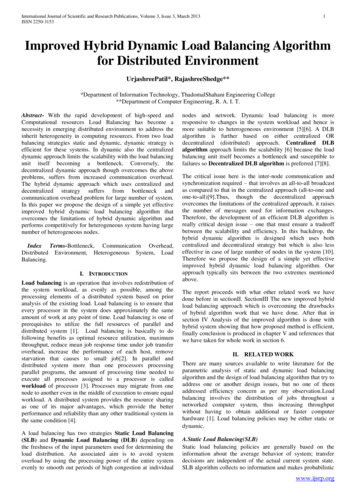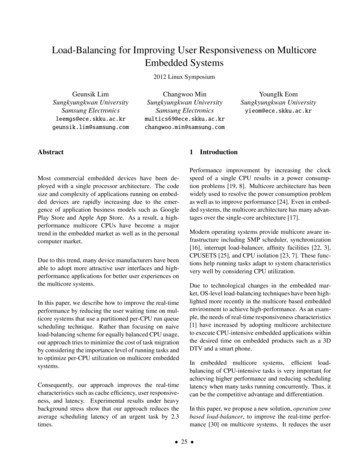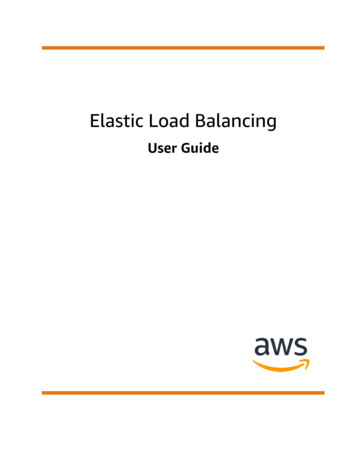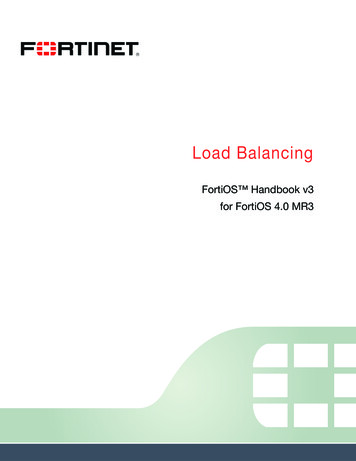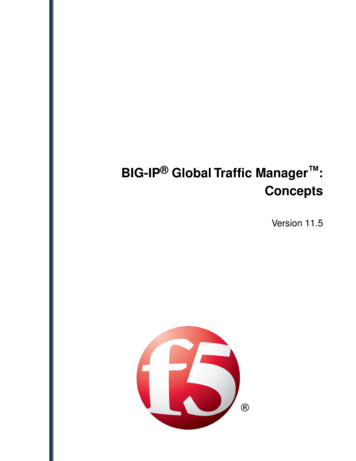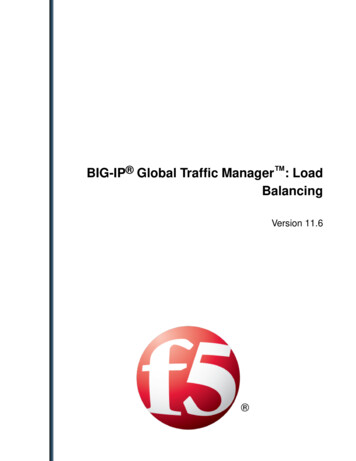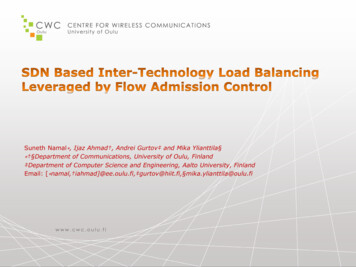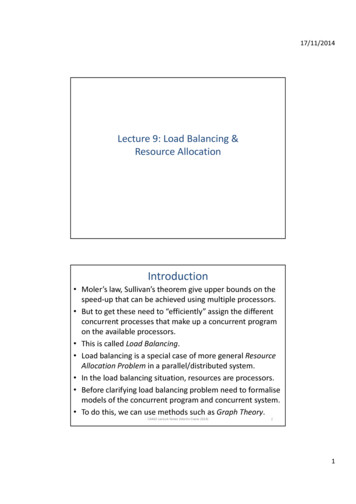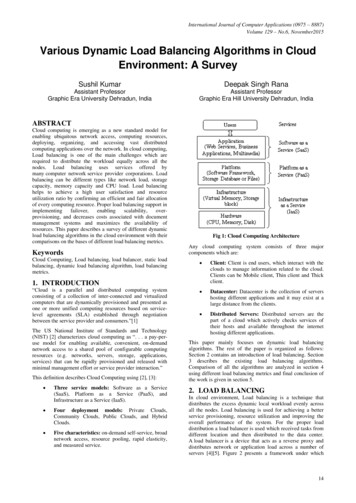
Transcription
International Journal of Computer Applications (0975 – 8887)Volume 129 – No.6, November2015Various Dynamic Load Balancing Algorithms in CloudEnvironment: A SurveySushil KumarDeepak Singh RanaAssistant ProfessorGraphic Era University Dehradun, IndiaAssistant ProfessorGraphic Era Hill University Dehradun, IndiaABSTRACTCloud computing is emerging as a new standard model forenabling ubiquitous network access, computing resources,deploying, organizing, and accessing vast distributedcomputing applications over the network. In cloud computing,Load balancing is one of the main challenges which arerequired to distribute the workload equally across all thenodes. Load balancing uses services offered bymany computer network service provider corporations. Loadbalancing can be different types like network load, storagecapacity, memory capacity and CPU load. Load balancinghelps to achieve a high user satisfaction and resourceutilization ratio by confirming an efficient and fair allocationof every computing resource. Proper load balancing support visioning, and decreases costs associated with documentmanagement systems and maximizes the availability ofresources. This paper describes a survey of different dynamicload balancing algorithms in the cloud environment with theircomparisons on the bases of different load balancing metrics.KeywordsCloud Computing, Load balancing, load balancer, static loadbalancing, dynamic load balancing algorithm, load balancingmetrics.Fig 1: Cloud Computing ArchitectureAny cloud computing system consists of three majorcomponents which are: Client: Client is end users, which interact with theclouds to manage information related to the cloud.Clients can be Mobile client, Thin client and Thickclient. Datacenter: Datacenter is the collection of servershosting different applications and it may exist at alarge distance from the clients. Distributed Servers: Distributed servers are thepart of a cloud which actively checks services oftheir hosts and available throughout the internethosting different applications.1. INTRODUCTION“Cloud is a parallel and distributed computing systemconsisting of a collection of inter-connected and virtualizedcomputers that are dynamically provisioned and presented asone or more unified computing resources based on servicelevel agreements (SLA) established through negotiationbetween the service provider and consumers.”[1]The US National Institute of Standards and Technology(NIST) [2] characterizes cloud computing as “. . . a pay-peruse model for enabling available, convenient, on-demandnetwork access to a shared pool of configurable computingresources (e.g. networks, servers, storage, applications,services) that can be rapidly provisioned and released withminimal management effort or service provider interaction.”This definition describes Cloud Computing using [2], [3]: Three service models: Software as a Service(SaaS), Platform as a Service (PaaS), andInfrastructure as a Service (IaaS). Four deployment models: Private Clouds,Community Clouds, Public Clouds, and HybridClouds. Five characteristics: on-demand self-service, broadnetwork access, resource pooling, rapid elasticity,and measured service.This paper mainly focuses on dynamic load balancingalgorithms. The rest of the paper is organized as follows:Section 2 contains an introduction of load balancing. Section3 describes the existing load balancing algorithms.Comparison of all the algorithms are analyzed in section 4using different load balancing metrics and final conclusion ofthe work is given in section 5.2. LOAD BALANCINGIn cloud environment, Load balancing is a technique thatdistributes the excess dynamic local workload evenly acrossall the nodes. Load balancing is used for achieving a betterservice provisioning, resource utilization and improving theoverall performance of the system. For the proper loaddistribution a load balancer is used which received tasks fromdifferent location and then distributed to the data center.A load balancer is a device that acts as a reverse proxy anddistributes network or application load across a number ofservers [4][5]. Figure 2 presents a framework under which14
International Journal of Computer Applications (0975 – 8887)Volume 129 – No.6, November2015various load balancing algorithms work in a cloud ver2In this policy it determines the availability of essentialresources for providing services and makes a selection basedon location of resources.2.3.4 Information PolicyLoadIn this policy it acquires workload related information aboutthe system such as nature of workload and the average load oneach node.Distribution n2.3.5 Load Estimation Policyst nLoad BalancerServer12.3.3 Location PolicyServernIn this policy it determines the total workload of a node in asystem.DataCentersData Base ClusterFig 2: Framework for working of Dynamic LoadBalancingLoad balancing is a technique of distributing the total load tothe individual nodes of the collective system to the facilitatenetworks and resources to improve the response time of thejob with maximum throughput in the system [6]. Theimportant things which said about load balancing areestimation of load, load comparison, different system stability,system performance, interaction between the nodes, nature ofwork to be transferred, selecting of nodes and many otherones to consider while developing such algorithm [7]. In thearea of cloud computing, the main objective of load balancingtechniques is to improve performance of computing in thecloud, backup plan in case of system failure, maintain stabilityand scalability for accommodating an increase in large scalecomputing, reduces associated costs and response time forworking in the cloud and also maximizes the availability ofresources [8].Next subsection explains types of Load balancing techniquesand main components of a dynamic load balancing algorithm.2.1 Static load balancing algorithmIn static load balancing algorithm it uses priori knowledge ofthe applications and statistical information about the systemand distributes the load equivalently between servers.2.2 Dynamic load balancing algorithmsDynamic load balancing algorithms are those algorithmswhich search for the lightest server in the network and thendesignated appropriate load on it. In this, work load isdistributed among the processors at runtime. The algorithmsin this category are considered complex, but have better faulttolerance and overall performance.2.3 Components of Dynamic LoadBalancing AlgorithmsA load balancing algorithm has five major components [9]2.3.1 Transfer PolicyIn this policy it is responsible to determine when a task shouldbe transferred from one node to the other node.2.3.2 Selection PolicyIn this policy it focuses on choosing the processor for loadtransfer so that the overall response time and throughput maybe udNetworkInformation PolicyFig 3: Components of Dynamic Load BalancingThere are various issues while dealing with load balancing ina cloud computing environment. Each load balancingalgorithm must be such as to achieve the desired goal. Somealgorithms aim to achieving higher throughput, minimumresponse time, and maximum resource utilization.3. EXISTING LOAD BALANCINGALGORITHMS INCLOUDCOMPUTINGIn cloud computing environment, there are various LoadBalancing Algorithms which are closely analyzed andcompared on the bases of some predefined metrics, includingthroughput, response time, Overhead, performance, faulttolerance, migration time, resource utilization, and scalability.Some of the commonly known Load Balancing Algorithmsare;Biased Random Sampling: Biased Random Samplingalgorithm [10] is a distributed and scalable load balancingapproach that uses random sampling of the system domain toachieve self-organization thus balancing the load across allnodes of the system. In this algorithm the load on a server isrepresented as a virtual graph having connectivity with eachnode. Each server is symbolized as a node in the graph, witheach in degree directed to the free resources of the server.Whenever a node executes a job, it deletes an incoming edge,which indicates a reduction in the availability of free resource.After completion of a job, the node adds on an incoming edge,indicating an increase in the availability of free resource.Random sampling is used for the increment and decrementprocesses [34]. The last node in the walk is selected forallocation of load; instead any other node based on certaincriteria could also be preferred. A node on receiving a job,will execute it only if its current walk length is equal to orgreater than the threshold value. Else, the walk length of thejob under consideration is incremented and another neighbournode is selected randomly. Again a new directed graph isformed and load balancing is achieved in a fully decentralizedmanner, thus making it suitable for large network systems likecloud[33].15
International Journal of Computer Applications (0975 – 8887)Volume 129 – No.6, November2015Active Clustering: Active Clustering algorithm [11][12]works on the principle of grouping the similar nodes and worktogether on the available groups. A set of processes isiteratively executed by each node on the network. Initially anynode can become an initiator and selects another node from itsneighbours to be the matchmaker node satisfying the criteriaof being a different type than the former one [34]. Thematchmaker node then forms a connection betweenneighbours of it which are similar to the initiator. Thematchmaker node then removes the connection between itselfand the initiator [33].Honey Bee Foraging: Honey Bee Foraging algorithm [13] isderived from the behaviour of honey bees for finding andreaping food. In order to check for fluctuation in demand ofservices, servers are grouped under virtual servers, having itsown virtual service queues. Each server processing a requestfrom its queue calculates a profit or reward on basis of CPUutilization, which is corresponds to the quality that the beesshow in their waggle dance and advertise on the advert board.Each of the servers takes the role of either a forager or a scout.A server serving a request, calculates its profit and compare itwith the colony profit, if profit was high, then the server staysat the current virtual server and if it was low, then the serverreturns to the forager or scout behaviour, thus balancing theload with the server[33].Join Idle Queue: Join Idle Queue load balancing algorithm[14] is applied for dynamically scalable web services. Thistechnique involves a dispatcher to whom processors informsat the time of their idleness, without interfering with jobarrivals. Thus removing the load balancing work from thecritical path of request processing, system load is reduced; nocommunication overhead at job arrivals and no increment inactual response time[33].Load Balance Min-Min (LBMM): LBMM schedulingalgorithm [15] and new optimized Load Balancing Max-MinMax (LB3M) [16] had main objective to minimize executiontime of each task, also avoid unnecessary replication of taskon the node thereby minimizing overall completion time.Opportunistic Load balancing algorithm when combined withLBMM (OLB LBMM) [15] keeps every node in workingstate to achieve load balance. Similar to LBMM, LB3M [16]also calculate average completion time for each task for allnodes. Then mark the task with maximum average completiontime. After that it dispatches the task of marked node to theunassigned node with minimum completion task, thusbalancing the workload evenly among all nodes[33].Ant Colony Optimization (ACO): ACO algorithm [17] ismainly proposed for load balancing of nodes and aimsefficient distribution of workload among the nodes[34]. Theant will start to move towards the source of the food from thehead node when the request is initialized. Ant records theirdata for future decision making and it keeps records for everynode and it makes a visit to the record. Every ant is build withtheir own individual result set and further built for giving thecomplete solution. It makes to update continuously with asingle result set rather than own result set is updating. This antworks in searching of new sources food with the use ofexisting food sources to shift the food back to the nest. Thismainly aims that efficient distribution of the load among thenodes. It does not encounter the dead end of the movement tothe node for building an optimum solution set. In ACO [18]two types of pheromones are used Foraging Pheromone (FP)used to explore overloaded node by forward movement ofants while Trailing Pheromone (TP) used to discover its pathback to the under loaded node. In order to limit the number ofants in the network, they would commit suicide once it findsthe target node [33].ACCLB (Load Balancing mechanism based on Ant Colonyand Complex network theory): In [19] author proposed a loadbalancing mechanism based on ant colony and complexnetwork theory in an open cloud computing federation. It usessmall world and scale-free characteristics of a complexnetwork to achieve better load balancing. This techniqueovercomes heterogeneity, is adaptive to dynamicenvironments, is excellent in fault tolerance and has goodscalability hence helps in improving the performance of thesystem.Exponential Smooth Forecast based on Weighted LeastConnection (ESWLC): ESWLC algorithm [20] is improvedform of Weighted Least-Connection (WLC) along with itsfeatures; it also takes into account time series and trials. WLCcounts the connections of each server and reports theappropriate server based on the multiplication of a serverweight and its count of connections. ESWLC algorithmconcludes assigning a certain task to a node only after gettingto know about the node capabilities. ESWLC builds thedecision based on the experience of the node’s CPU power,memory, number of connections and the amount of disk spacecurrently being used. ESWLC then predicts which node is tobe selected based on exponential smoothing[33].Honey Bee Behaviour inspired Load Balancing (HBB-LB):According to [21][22] ,HBB-LB is a technique, which helpsto achieve even load balancing across virtual machine tomaximize throughput. It considers the priority task waiting inqueue for execution in virtual machines. After that, the workload on VM calculated decides whether the system isoverloaded, under load or balanced and based on these VMsare grouped [34]. According to the load on VM the task isscheduled on VMs, which is removed earlier. To find thecorrect low loaded VM for the current task, tasks which areremoved earlier from over loaded VM are helpful. Foragerbee is used as a Scout bee in the next steps [33].Power Aware Load Balancing for Cloud Computing(PALB): In PALB algorithm [23], the utilization percentagesof each compute node is estimated. This helps in deciding thenumber of computing nodes which must keep operating whileother nodes completely shut down. The algorithm has threesections: Balancing section, Upscale section and Downscalesection. Balancing section is responsible for determiningwhere virtual machines will be instantiated based onutilization percentages. The upscale sections power-on theadditional compute nodes and the downscale sectionshutdowns the idle compute nodes. This algorithm isguaranteed to decrease the overall power consumption whilemaintaining the availability of resources as compared to otherload balancing algorithms.Equally Spread Current Execution (ESCE): According to[24], ESCE is a dynamic load balancing algorithm, whichhandles the process with priority. It determines the priority bychecking the size of the process. This algorithm distributes theload randomly by first checking the size of the process andthen transferring the load to a virtual machine, which is lightlyloaded. The load balancer spreads the load on different nodes,and hence, it is known as spread spectrum technique.Throttled Load Balancer (TLB): Throttled load balancer is adynamic load balancing algorithm [24] in which the clientfirst requests the load balancer to find a suitable virtual16
International Journal of Computer Applications (0975 – 8887)Volume 129 – No.6, November2015Migration time: Migration is the time of movement of job ofthe master system to the slave system and vice versa in case ofresults. Migration time is the overhead, which cannot beremoved but should be minimized.Response Time: It is the amount of time taken to respond bya particular load balancing algorithm in a distributed system.This parameter should be minimized.Resource Utilization: It is used to check the utilization ofresources. It should be optimized for an efficient loadbalancing.Scalability: It is the ability of an algorithm to perform loadbalancing for a system with any finite number of nodes. Thismetric should be improved.Performance: It is used to check the efficiency of the system.This has to be improved at a reasonable cost, e.g., reduce taskresponse time while keeping acceptable delays.Table 1 shows the comparisons of the dynamic load balancingalgorithm, which were discussed in section 3.Table 1: Comparisons of existing Load s( )ResourceUtilizationVector Dot: In [31][32], Vector Dot approach holds thehierarchical complexes of the data center andmultidimensionality of resource piles crosswise servers,Fault Tolerance: Fault tolerance system is a system in whichthe processing does not get affected because of the failure ofany particular processing device in the system. The loadbalancing should be fault tolerant.ResponseTimeCompare and Balance: According to [30][31], Compare andBalance algorithm uses the concept of compare and balance toreach equilibrium condition and manage unbalanced system’sload on the basis of probability (number of virtual machinesrunning on the current host and whole cloud system). Thecurrent node selects randomly a node and compares the loadwith itself.Overhead: It determines the amount of overhead involvedwhile implementing a load balancing algorithm. Overheadshould be minimized so that a load balancing technique canwork efficiently.MigrationTimeStochastic Hill Climbing: According to [29], Stochastic HillClimbing is a soft computing based load balancing approachwhich is used for allocation of incoming jobs to the servers orvirtual machines (VMs). There are two main families ofprocedures for solving an optimization problem. Completemethods which guarantee either to find a valid assignment ofvalues to variables or prove that no such assignment exists.These methods frequently exhibit good performance, andguarantee a correct and optimal answer for all inputs.Unfortunately, they require exponential time in the worst case,which is not acceptable in the cloud computing domain. Theother incomplete methods may not guarantee correct answersfor all inputs. Rather, these methods find satisfyingassignments for solvable problems with high probability.After studying the dynamic load balancing algorithms, wehave compared all the algorithms on the bases of somepredefined metrics. These metrics are as follows [34]:Throughput: Throughput is used to calculate the number ofjobs whose execution has been completed. It should be high toimprove the performance of the system.FaultToleranceParticle Swarm Optimization (PSO) Algorithm: ParticleSwarm Optimization (PSO) as a meta-heuristics method is aself-adaptive global search based optimization techniqueintroduced by Kennedy and Eberhart [27]. The PSO algorithmis alike to other population-based algorithms like Geneticalgorithms (GA) but, there is no direct recombination ofindividuals of the population. The PSO algorithm focuses onminimizing the total cost of computation of an applicationworkflow. The objective is to minimize the total cost ofexecution of application workflows on Cloud computingenvironments. Results show that PSO based task-resourcemapping can achieve at least three times cost savings ascompared to Best Resource Selection (BRS) based mappingfor application workflow. In addition, PSO balances the loadon compute resources by distributing tasks to availableresources[28].4. LOAD BALANCING METRICS ANDCOMPARISON OF THE ENTIREALGORITHMSOverheadGenetic Algorithm (GA): According to [25], GeneticAlgorithm has been used as a soft computing approach, whichuses the mechanism of natural selection strategy. A simpleGenetic Algorithm is composed of three operations: geneticoperation, selection, and replacement operation. Theadvantage of this technique is that it can handle a vast searchspace applicable to complex objective function and can avoidbeing trapped in locally optimal solution. A generation is acollection of artificial creatures (strings). In every newgeneration, a set of strings is created using information fromthe previous ones. Occasionally, a new part is effort for goodmeasure. According to [26] Genetic Algorithms arerandomized, but they are not simple random walks. Theyadept exploit historical information to speculate on newsearch points with expected improvement. The effectivenessof the GA depends in appropriate mix of exploration andexploitation.network switches, and storage in a nimble data center that hasdesegregated server and memory virtualization engineeringsciences. Vector Dot exercises dot product to differentiatenodes based on the item necessities and helps in getting rid ofoverburdens on servers, switches and storage nodes.Throughputmachine to perform the required operation. In Cloudcomputing, there may be multiple instances of virtualmachine. These virtual machines can be grouped based on thetype of requests they can handle. Whenever a client sends arequest, the load balancer will first look for that group, whichcan handle this request and allocate the process to the lightlyloaded instance of that NYNYNYNNHoney beeForagingNNNNNYNNJoin IdlequeueNYNNYNNYAlgorithms( )17
International Journal of Computer Applications (0975 – 8887)Volume 129 – No.6, asticHillClimbingYNNNYYNYCompare &BalanceNYNYNYNNVector DotYNNNNYNN5. CONCLUSIONIn the cloud computing environment, load balancing is one ofthe main issues, which is required to distribute dynamic localworkload to all the nodes in the cloud to improve theperformance and maximize resource utilization. This paperexplains cloud computing, load balancing, types of loadbalancing algorithms, components of dynamic load balancingalgorithms and load balancing metrics. This paper primarilyfocuses on dynamic load balancing algorithm in cloudenvironment. For this, various existing dynamic loadbalancing algorithms are surveyed. By comparing thealgorithms on different metrics tried to find the scope forimproving fault tolerance, throughput, performance, resourceutilization and minimizing response time, migration time,overhead in the load balancing algorithm. Future work isrelated to designing a new dynamic load balancing algorithmwith fault tolerance for better resource utilization, minimumresponse time and fast throughput of the cloud computingenvironment.6. REFERENCES[1] R. Buyya, C. S. Yeo, S. Venugopal, J. Broberg, and I.Brandic, Cloud computing and emerging IT platforms:Vision, hype, and reality for delivering computing as the5th utility, Future Generation Computer Systems,25:599 616, 2009.[2] P. Mell and T. Grance, The NIST Definition of CloudComputing, National Institute of Standards andtechnology, Information Technology Laboratory,Technical Report Version 15, 2009.[3] Rimal, Bhaskar Prasad, Eunmi Choi, and Ian Lumb. "Ataxonomy and survey of cloud computing systems." INC,IMS and IDC, 2009. NCM'09. Fifth International JointConference on. IEEE, 2009.[4] L. M. Vaquero, L. Rodero-Merino, J. Caceres and M.Lindner, “A break in the clouds: towards a clouddefinition,”SIGCOMMACMComputerCommunication Review,vol. 39, pp. 50–55, December2008.[5] Rahman, Mazedur, Samira Iqbal, and Jerry Gao. "LoadBalancer as a Service in Cloud Computing." In ServiceOriented System Engineering (SOSE), 2014 IEEE 8thInternational Symposium on, pp. 204-211. IEEE, 2014.[6] R. Shimonski. “Windows 2000 & Windows Server 2003Clustering and Load Balancing”, Emeryville. McGrawHill Professional Publishing, CA, USA (2003), p 2,2003.[7] Ali M. Alakeel, “A Guide to Dynamic Load Balancing inDistributed Computer Systems”, IJCSNS InternationalJournal of Computer Science and Network Security,VOL.10 No.6, June 2010.[8] M.Armbrust, A.Fox, R. Griffit,et al., “A view of cloudcomputing”, Communications of the ACM, vol. 53, no.4,pp. 50–58, 2010.[9] M. Amar, K. Anurag, K. Rakesh, K. Rupesh, Y. Prashant(2011). SLA Driven Load Balancing For WebApplications in Cloud Computing Environment,Information and Knowledge Management, 1(1), pp. 5-13,2011.[10] O. Abu- Rahmeh, P. Johnson and A. Taleb-Bendiab, “ADynamic Biased Random Sampling Scheme for Scalableand Reliable Grid Networks”, INFOCOMP - Journal ofComputer Science, ISSN 1807-4545, 2008, VOL.7, N.4,December, 2008, pp. 01-10.[11] F. Saffre, R. Tateson, J. Halloy, M. Shackleton and J.L.Deneubourg, “Aggregation Dynamics in OverlayNetworks and Their Implications for Self-OrganizedDistributed Applications.” The Computer Journal, March31st, 2008.[12] Dhurandher, Sanjay K., Mohammad S. Obaidat, IsaacWoungang, Pragya Agarwal, Abhishek Gupta, andPrateek Gupta. "A cluster-based load balancingalgorithm in cloud computing." In Communications(ICC), 2014 IEEE International Conference on, pp.2921-2925. IEEE, 2014.[13] Randles, M., D. Lamb and A. Taleb-Bendiab, “AComparative Study into Distributed Load BalancingAlgorithms for Cloud Computing,” in Proc. IEEE 24thInternational Conference on Advanced InformationNetworking and Applications Workshops (WAINA),Perth, Australia, April 2010.[14] Yi Lua, Qiaomin Xiea, Gabriel Kliotb, Alan Gellerb,James R. Larusb, Albert Greenbergc, “ Join-Idle-Queue:A Novel Load Balancing Algorithm for DynamicallyScalable Web Services” Volume 68 Issue 11, November,2011, pp:1056-1071, Elsevier Science Publishers, 2011.[15] S. Wang, K. Yan, W. Liao, and S. Wang, “Towards aLoad Balancing in a Three-level Cloud ComputingNetwork”, Proceedings of the 3rd IEEE InternationalConference on Computer Science and InformationTechnology (ICCSIT), Chengdu, China, September2010, pages 108-113.[16] Che-Lun Hung, Hsiao-hsi Wang and Yu-Chen Hu“Efficient Load Balancing Algorithm for CloudComputing Network”, International Conference onInformation Science and Technology (IST 2012), April28-30, pp; 251-253.18
International Journal of Computer Applications (0975 – 8887)Volume 129 – No.6, November2015[17] Nishant, K. P. Sharma, V. Krishna, C. Gupta, KP. Singh,N. Nitin and R. Rastogi, "Load Balancing of Nodes inCloud Using Ant Colony Optimization." In proc. 14thInternational Conference on Computer Modelling andSimulation (UKSim), IEEE, pp: 3-8, March 2012.[18] Dam, Santanu, Gopa Mandal, Kousik Dasgupta, andParamartha Dutta. “An Ant Colony Based LoadBalancing Strategy in Cloud Computing.” In AdvancedComputing, Networking and Informatics-Volume 2, pp.403-413. Springer International Publishing, 2014.[19] Zhang, Z. and X. Zhang, "A load balancing mechanismbased on Ant Colony and Complex Network Theory inOpen Cloud Computing federation." In proc. 2ndInternational Conference on. Industrial Mechatronics andAutomation (ICIMA), IEEE, Vol. 2, pp:240-243, May2010.2011.[26] Dam, Scintami, et al. "Genetic algorithm andgravitational emulation based hybrid load balancingstrategyincloudcomputing." Computer,Communication, Control and Information Technology(C3IT), 2015 Third International Conference on. IEEE,2015.[27] Pandey, Suraj, Linlin Wu, Siddeswara Mayura Guru, andRajkumar Buyya. "A particle swarm optimization-basedheuristic for scheduling workflow applications in cloudcomputing environments." In Advanced InformationNetworking and Applications (AINA), 2010 24th IEEEInternational Conference on, pp. 400-407. IEEE, 2010.[28] Gwalior, India. "An Analysis of Swarm Intelligencebased Load Balancing Algorithms in a Cloud ComputingEnvironment." (2015).[20] Ren, X., R. Lin and H. Zou, "A dynamic load balancingstrategy for cloud computing platform based onexponential smoothing forecast" in proc. InternationalConference on. Cloud Computing and IntelligentSystems (CCIS), IEEE, pp: 220-224, September 2011.[29] Mondal, Brototi, Kousik Dasgupta, and ParamarthaDutta. "Load balancing in cloud computing ."Procedia Technology 4 (2012): 783-789.[21] Dhinesh B. L.D , P. V. Krishna, “Honey bee behaviorinspired load balancing of tasks in cloud computingenvironments”, in proc. Applied Soft Computing,volume 13, Issue 5, May 2013.[30] Y. Zhao, and W. Huang, “Adaptive Distributed LoadBalancing Algorithm based on Live Migration of VirtualMachines in Cloud”, Proceedings of 5th IEEEInternational Joint Conference on INC, IMS and IDC,Seoul, Republic of Korea, August 2009, pages 170-175.[22] Ganesh, Amal, M. Sandhya, and Sharmila Shankar. "Astudy on fault tolerance methods in Cloud Computing."In Advance Computing Conference (IACC), 2014 IEEEInternational, pp. 844-849. IEEE, 2014.[23] Galloway, Jeffrey M., Karl L. Smith, and Susan S.Vrbsky. "Power aware load balancing for cloudcomputing." Proceedings of the World Congress onEngineering and Computer Science. Vol. 1. 2011.[24] Domanal, Shridhar G., and G. Ram Mohana Reddy."Load Balancing in Cloud Computingusing ModifiedThrottled Algorithm." Cloud Computing in EmergingMarkets (CCEM), 2013 IEEE International Conferenceon. IEEE, 2013.[25] Ye, Zhen, Xiaofang Zhou, and Athman compositions in cloud computing." Database systems foradvanced applications. Springer Berlin Heidelberg,IJCATM : www.ijc
Load balancing is a technique of distributing the total load to the individual nodes of the collective system to the facilitate networks and resources to improve the response time of the job with maximum throughput in the system [6]. The important things which said about load balancing are estimation of load, load comparison, different system .
